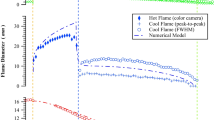Abstract
The temperature dependent corrections of the formaldehyde laser induced fluorescence raw signal are discussed for the 355 nm excitation, which is widely available as the third harmonic of Nd-YAG lasers. The temperature dependence of the HCHO partition function is calculated explicitly and the effect of quenching corrections is discussed in view of the absence of experimental data on collision cross-sections. Particular reference is made to the case of HCHO layers in hydrocarbon diffusion flames. It is shown that the thickness of such layers is not affected drastically by the calculated corrections, which has implications for the estimate of the scalar dissipation rate in diffusion flames.



Similar content being viewed by others
References
Barry HR, Corner L, Hancock G, Peverall R, Ranson TL, Ritchie GAD (2003) Measurements of pressure broadening coefficients of selected transitions in the 2ν5 band of formaldehyde. Phys Chem Chem Phys 5:3106–3112
Bijjula K, Kyritsis DC (2004) Experimental evaluation of flame observables for simplified scalar dissipation rate measurements in laminar diffusion flamelets. Proc Combust Inst (in press)
Brackmann C, Nygren J, Bai X, Li Z, Bladh H, Axelsson B, Denbratt I, Koopmans L, Bengtsson P-E, Aldén M (2003) Laser-induced fluorescence of formaldehyde in combustion using third harmonic Nd:YAG laser excitation. Spectrochim Acta A 59:3347–3356
Clouthier DJ, Ramsay DA (1983) The spectroscopy of formaldehyde and thioformaldehyde. Ann Rev Phys Chem 34:31–58
Dieke GH, Kistiakowski GB (1934) Ultraviolet absorption spectrum of formaldehyde. Phys Rev 45:4–44
Eckbreth AC (1987) Laser diagnostics for combustion, temperature and species. Abacus Press, Cambridge, MA
Harrington JE, Smyth KC (1993) Laser-induced measurements of formaldehyde in a methane/air diffusion flame. Chem Phys Lett 202:196–202
Herzberg G (1991) Molecular spectra and molecular structure. Krieger, Malabar, FL
Karpetis AN, Settersten TB, Schefer RW, Barlow RS (2004) Laser imaging system for determination of three-dimensional scalar gradients in turbulent flames. Opt Lett 29:355–357
Klein-Douwel RJH, Luque J, Jeffries JB, Smith GP, Crosley DR (2000) Laser induced fluorescence of formaldehyde hot bands in flames. Appl Opt 39:3712–3715
Kyritsis DC, Santoro VS, Gomez A (2002) Quantitative scalar dissipation rate measurements in vortex-perturbed counterflow diffusion flames. Proc Combust Inst 29:1679–1685
Moule DC, Walsh AD (1975), Ultraviolet spectra and excited states of formaldehyde. Chem Rev 75:67–83
Paul PH, Najm HN (1998) Planar laser-induced fluorescence imaging of flame heat release rate. Proc Comb Inst 27:43–50
Santoro VS, Kyritsis DC, Gomez A (2000) An experimental study of vortex flame interaction in counterflow spray diffusion flames. Proc Combust Inst 28:1023–1030
Shin DI, Dreier T, Wolfrum J (2001) Spatially resolved absolute concentration and fluorescence-lifetime determination of H2CO in atmospheric-pressure CH4/air flames. Appl Phys B 72:257–261
Williams FA (1985) Combustion theory. Addison-Wesley, Redwood City, CA
Acknowledgements
The authors would like to acknowledge Mr K. Bijjula of UIUC/ M&IE Dept. for providing data for the revised version of this note.
Author information
Authors and Affiliations
Corresponding author
Rights and permissions
About this article
Cite this article
Kyritsis, D.C., Santoro, V.S. & Gomez, A. The effect of temperature correction on the measured thickness of formaldehyde zones in diffusion flames for 355 nm excitation. Exp Fluids 37, 769–772 (2004). https://doi.org/10.1007/s00348-004-0860-9
Received:
Accepted:
Published:
Issue Date:
DOI: https://doi.org/10.1007/s00348-004-0860-9




